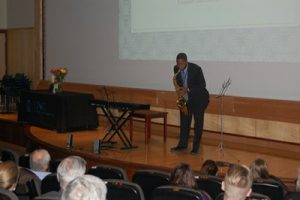 On Friday, Jan. 31, the class of 2017 hosted this year’s Cadaver Memorial Service in the MBRB Auditorium. A tradition among first-year students at the UNC School of Medicine, the service commemorates those who donate their bodies for medical education and marks the completion of the anatomy block.
On Friday, Jan. 31, the class of 2017 hosted this year’s Cadaver Memorial Service in the MBRB Auditorium. A tradition among first-year students at the UNC School of Medicine, the service commemorates those who donate their bodies for medical education and marks the completion of the anatomy block.
According to faculty that have attended many cadaver memorial services, this year’s ceremony was as well attended as any previous service. “We were told that it was a very impressive showing,” said Judd Heideman, MS1 co-president. “It may have been the first time the entire upper balcony was filled.”
In addition to first-year medical students, the service was attended by first-year dental and OT/PT students who also worked with the cadavers. The hour-long ceremony included individual musical performances by medical students Humphrey Fang on violin, Graham Mulvaney on saxophone, and Mona Xiao on piano, as well as a duet by Katie Weinel and Hannah Noah on flute and piano and a vocal performance by the MedUNCedoos. You may view the program here and listen to the ceremony here.
Xiao, who performed Franz Liszt’s Liebestraum, was proud to honor the donors and their families. “It was a wonderful experience to be able to express my gratitude to the families and friends of the donors, as well as to our classmates in the audience who participated in the experience,” she said. “The experience brings closure to the last several months and acknowledges and pays respects to the people we got to know in such an intimate way.”
The service meant a lot to first-years such as Khadijah Bhatti. “As students, we all had our own unique emotional journeys,” she said. “We didn’t know the donors when they were alive but had such a visceral interaction with them, and I think this was a really wonderful way to give some solace for our feelings.”
Perhaps most difficult for Bhatti and her classmates was learning to detach from the individuals who lay before them throughout the anatomy block.
“The challenge isn’t learning to see the human side of the person,” said Bhatti. “It was exactly the opposite. It was very difficult to forget that you’re interacting with a human being. When you’re in the lab, you learn ways to cope with the humanness of it and to view the learning as a tribute as opposed to a deconstructing action. I don’t think anyone in our class forgot that we were interacting with humans in a way that we will never do again.”
The ceremony finished with a moving slideshow of pictures of the donors when they were alive, with biographies shared alongside the images. Quotes from loved ones and medical students splashed on the screen, while music played throughout the auditorium. “The slideshow was a personal, heartfelt ‘thank you’ from our class,” said Heideman. “It was a small token but it served as a nice embrace between the class and the families.”
Preparing and organizing the event, which is the responsibility of class co-presidents, was a collective effort. MS1 co-president Billy Oslund was impressed by how the class came together to pull off the event.
“It couldn’t have been done without the help of the entire class,” said Oslund. “The talents of our classmates were astounding. But even those who didn’t perform were able to participate. People volunteered to organize the reception, to arrive early and help set up, and to do things like bring food for the reception.”
During the ceremony, co-director of anatomy, Kurt Gilliland, PhD, professor in the Department of Cell and Developmental Biology, read a letter from a donor from years ago that expressed the personal reasons for donation. Edward Kernick, DPM, an assistant professor in the Department of Cell and Developmental Biology and also co-director of the anatomy course, read a poem from a former student.
Heideman credits their teachers for setting the tone of appreciation and respect early in the anatomy block with small group reflections, an exercise that helped students work through their feelings and understand the importance of body donation. “It was a first emotional release,” said Heideman. “We talked about those early experiences, how it felt, and what the significance of working with the human body means to us. Having those built-in, curricular, and structured approaches prepared us for the human element of anatomy.”
Oslund agrees. “We learned not to see them just as cadavers, but to have an added level of respect for them because they were people,” said Oslund. “That got everyone thinking about how special the experience is, which in turn improved the learning because we took it so seriously. We realized that we didn’t have a choice – we had to take as much as we could from it because this person who donated his or her body wanted us to take advantage of the opportunity.”